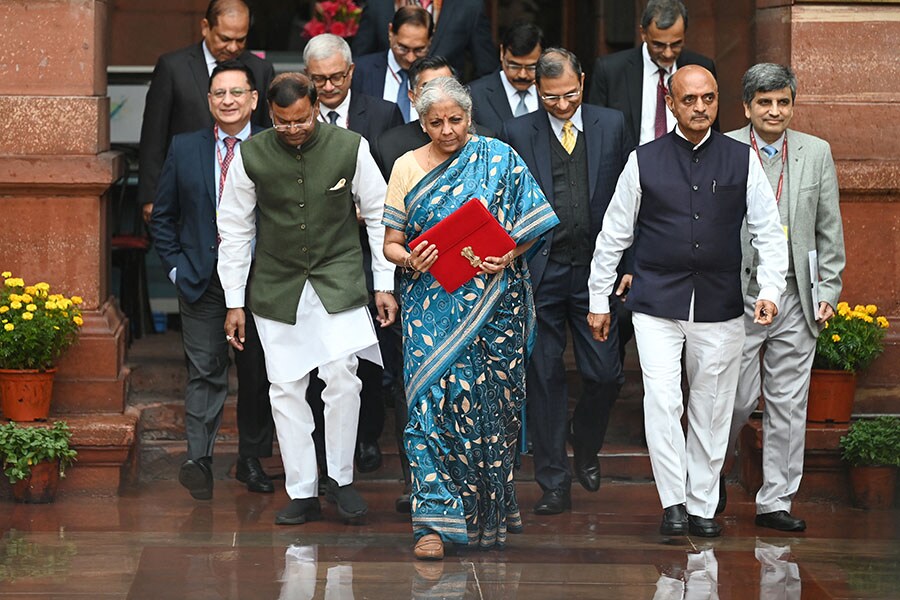
Budget 2024: The only surprise, no surprise
By Samar Srivastava| Feb 1, 2024
In an election year the Finance Minister presented a pragmatic Budget with no giveaways
 [CAPTION]India's Finance Minister Nirmala Sitharaman (C) holds the briefcase containing the annual budget documents as she leaves the Finance ministry with her staff to present the budget in the parliament in New Delhi on February 1, 2024.
Image: Sajjad Hussain / AFP [/CAPTION]
[CAPTION]India's Finance Minister Nirmala Sitharaman (C) holds the briefcase containing the annual budget documents as she leaves the Finance ministry with her staff to present the budget in the parliament in New Delhi on February 1, 2024.
Image: Sajjad Hussain / AFP [/CAPTION]
Those looking for tax sops, cash giveaways and loan waivers in the interim Budget were in for a disappointment. There were none of those.
In plentiful supply were fiscal rectitude, slightly lower spending and a continued build out of the country’s infrastructure. These markers of the Budget pointed to a government that was as confident of its management of the economy as it is of coming back for another full term.
_RSS_In a short 58-minute speech the part that is likely to cheer the markets in the weeks ahead came at the very end. In keeping with its earlier commitment the government plans to stick to its target of getting to a 4.5 percent fiscal deficit by 2025-26. This is significant given the rise in deficit financing during the Covid period. For FY24 the revised deficit number is 5.8 percent and FY25 at 5.1 percent. This immediately cheered the bond markets with bond yields falling to 7.08 percent.
With the inclusion of Indian bonds in global bond indices later this year keeping the currency stable was a likely key aim of the Budget. This would ensure a healthy appetite for government bonds in the years to come. (There were also extensions on the tax status of the GIFT City that would expire in March 2024. This had been a key demand of global investors looking to set up there.)
With government borrowings in check there’s likely to be less money to spend on for schemes like PM Kisan. As a result, there was no increase in the amount to be paid to farmers from the current Rs 6000 a year.
There were also no new handouts to either women or other marginalised groups—a strategy that state governments have pursued over the last few years. Also not mentioned was rural distress that is seen in the increased allocation for MNREGA from Rs 60,000 crore in FY23 to Rs 86,000 crore in the FY24 revised estimates. Supporting lower income households through cash transfers is something that has been put off for after the elections. With consumer spending contributing to two-thirds of growth in India this is an important lever that will have to be addressed.
Also read: Budget 2024: With infrastructure in mind, the Modi government has upped India's capital expenditure outlay
Instead there was more money for infrastructure spends albeit less than anticipated. The number went up 11 percent to Rs 11,11,111 crore. This was lower than the 34 percent increase for FY24 but still amounts to 3.4 percent of GDP. Off Budget there is likely to be an increase through private spends like the three railway corridors announced or for coal gasification projects or tourism infrastructure. These should add to the multiplier effect on private capex that the government has been hoping for for the last few years.
Those looking for clues to priorities for the next five years need look no further than the PM Awas Yogana and the recently announced rooftop solar programme. These pet initiatives championed by the Prime Minister are likely to have a multiplier effect. Under the Awas Yogana, which provides an interest subvention on loans, three million homes have been built in the last five years and the Budget announced a two million home target for the next five. Home building industries from paints to plumbing and lighting to cement should continue to benefit.
The rooftop solar project will provide for 300 units of electricity per month per household enabling them to save Rs 15,000 -18,000 annually as well as reduce India’s dependence on coal. Expected are incentives for the installation of these panels as well as helping households offer their services for charging electric vehicles. If implemented properly this could help lower income households save substantially on their electricity bills.
Expect periodic announcements on the housing and solar front over the next five years. As a start a new scheme is planned for renters to become home-owners. Expect some money for that. Without breaking the bank of course.